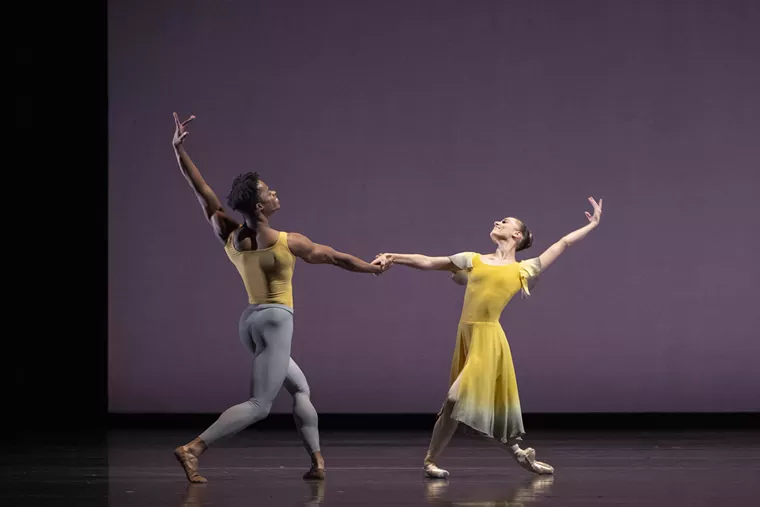Review: Rock, Roll & Tutus at Houston Ballet
Few things are as exciting as when Houston Ballet stages a Rock, Roll & Tutus mixed repertory program, and it’s not just because rock music makes an appearance where some think it doesn’t belong. It’s because without fail, the rock ‘n’ roll spirit – with its promise of intimacy and spectacle, subtlety and bravado – will run through every work selected for the program, making for one exciting night at the ballet.
And last night was no exception.
The program opened with a bang in the form of Brett Ishida’s what i was thinking while i was waltzing, a Houston Ballet commission that originally premiered during last year’s Margaret Alkek Williams Jubilee of Dance.
The curtain rises to reveal five couples twirling around the stage like figurines in a music box. Between the women’s blood-red dresses and Ezio Bosso’s über dramatic String Quartet No. 5, music from a live score the Italian composer wrote for a 1927 Alfred Hitchcock thriller, we are immediately struck both visually and sonically. Then, one by one, the women, with arms outstretched and backs arched, appear to be, in turn, waking up, struggling against, and transforming, eventually disappearing into the drapey vermilion of their self-standing skirts only to crawl out, emerging from the cocoon of artifice somewhere darker.
what i was thinking while i was waltzing is seductive and gripping, unflinching and raw, like an exposed nerve. Ishida’s escape into the subconscious is sensuous and visceral, drawing on precision, slow and dream-like, and varied technique, from pointe work to kip-ups and bridge poses. The partnering is especially breathtaking, with Saul Newport and Brittany Stone delivering standout performances. By the time the women climb back into their dresses and the couples resume their waltz, the curtain closing on a whirl of spinning lifts sweeping across the stage, it was clear: This is a piece you’re guaranteed to want to see again, and again, and again.
Houston Ballet First Soloists Tyler Donatelli and Naazir Muhammad in Jacquelyn Long’s Illuminate.
Photo by Alana Campbell (2025). Courtesy of Houston Ballet
After a brief pause, another work that first premiered at a Margaret Alkek Williams Jubilee of Dance takes the stage. This time, it’s Houston Ballet Soloist Jacquelyn Long’s debut work, Illuminate.
Set to Oliver Davis’s Frontiers, Concerto for Violin and Strings, Illuminate is like sorbet, a palate cleanser, a refreshing and delightful contrast to the previous work. Choreographed for an ensemble of six, the short dance, set in three movements, is light and airy, and strong in its romanticism. Long displays strong musicality, the steps clean and accessible, with the dancers positively spritely to match the violin part played masterfully by Denise Tarrant.
If you’re the type to read the program given to you on the way in, you’ll read that themes of ideas and inspiration are embedded in the work, though the dance itself is quite ambiguous, the only real hint to those themes the lightbulb hanging stage left. Illuminate, however, is not at all ambiguous in its joy. It is bright and infectiously happy. Long also knows how to end on a high note, the ending pose with the dancers all reaching toward the light memorable all on its own.
One 25-minute intermission later, Christopher Bruce’s Rooster undeniably brought the rock star swag to the evening’s program.
Created in 1991 for Ballet du Grand Theatre de Geneve, and receiving its American premiere right here at Houston Ballet in 1995, Rooster is an irresistibly fun dance for ten, five men and five women, set to eight different songs by The Rolling Stones. Each song is its own little vignette, connected via the repeated gestures and motifs Bruce draws directly from the lyrics.
Houston Ballet Principal Connor Walsh, Demi Soloist Jack Wolff and Corps de Ballet Dancer Alejandro Molina León in Christopher Bruce’s Rooster.
Photo by Alana Campbell (2025). Courtesy of Houston Ballet.
Bruce starts the piece with the bluesy “Little Red Rooster,” and, as the song goes, the “little red rooster is on the prowl.” In this case, it’s Connor Walsh, who appears on stage, strutting, repeatedly fixing his hair and straightening his tie, and generally peacocking around, establishing a recurring theme for the men.
There seems to be a sexual tug-of-war at play, with the men certainly acting as though the power is on their side, as during “Lady Jane,” as male attention flits from one woman to another. The women, however, occasionally triumph, like during “Not Fade Away,” a punchy number that features a preening Jack Wolff, who certainly tries to embody the demands of Jagger’s words, though he still gets kicked down, stepped on, and eventually carried away.
Rooster is filled with memorable performances, including Karina González’s child-like outcast in “As Tears Go By”; the bop of a solo by Alejandro Molina León during “Paint It Black”; and Jessica Collado’s gentle portrayal in “Ruby Tuesday.”
Following a shorter, 15-minute intermission, the centerpiece of the evening, Vi et animo from Stanton Welch, commenced to impress the audience.
Houston Ballet Principals Yuriko Kajiya and Aaron Robison with Artists of Houston Ballet in Stanton Welch’s Vi et Animo.
Photo by Alana Campbell (2025). Courtesy of Houston Ballet.
After choreographing the first movement of Pyotr Ilyich Tchaikovsky’s Piano Concerto No. 1 for the Margaret Alkek Williams Jubilee of Dance in 2023, Welch expanded the work to encompass all three of Tchaikovsky’s movements, which now debut as part of the mixed rep program. And expanded it is, featuring nearly 50 dancers across its three movements.
Vi et animo evokes George Balanchine, with its classical vocabulary and a sea of tutus emphasizing the piece’s grandeur. The first movement is characterized by delicate footwork and gorgeous port a bras from the ensemble mixed with spotlight-demanding solos tailor-made for Welch’s dancers. Though all deserved their oohs and ahhs, the power and acrobatics of the men – Eric Best, Naazir Muhammad, and Simone Acri – juxtaposed too perfectly with the broader dance to not deserve a special mention. Welch marries the beautiful lyricism of Tchaikovsky’s second movement with a breakable pas de deux danced by Karina González and Harper Watters, before turning to Sayako Toku and Angelo Greco to lead the corps in a more playful, and quicker, third movement.
Mixed repertory programs are perfect starter packs for people who aren’t familiar with dance and special treats for those who are. One again, Houston Ballet is offering four contrasting pieces that show the breadth of what the company has to offer, and it’s nothing if not impressive.

Reign Bowers is an outdoor enthusiast, adventure seeker, and storyteller passionate about exploring nature’s wonders. As the creator of SuperheroineLinks.com, Reign shares inspiring stories, practical tips, and expert insights to empower others—especially women—to embrace the great outdoors with confidence.







Post Comment